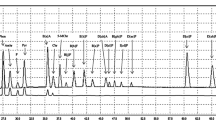Abstract
A study was undertaken to evaluate aflatoxin B1 contamination in coffee beans. 41 samples of green coffee were collected from large lots of material by representative sampling. The raw samples were analyzed and showed no detectable levels of aflatoxin B1. In order to establish the heat stability of the toxin, 3 artificially contaminated samples (average level 10/μg/kg) were roasted atca 200°C for different operation times periods so as to reproduce light and dark roasting procedures. Each sample was roasted both electrically and by gas.
The percentage of toxin destruction was up to 93% for light roasted and 99% for dark roasted coffee with a slightly higher rate up to 100% for the electrically roasted coffee for light and dark roasting. In order to evaluate the potential migration of the aflatoxin B1 into the coffee beverage, 1 sample found contaminated after roasting treatment (0.8/°g/kg) was extracted using each of the 3 most common types of coffee makers. Additional destruction of the toxin was observed (up to 99%) in two cases while only 75% of fate was obtained in the third.
The process from raw coffee beans to beverage showed a meaningful destruction of aflatoxin B1, ranging from 97 to 100% depending on the extraction technique adopted in the preparation of the beverages.
Similar content being viewed by others
References
Buchanan RL and Flechter AM (1978) Methylxanthine inhibition of aflatoxin production. J Food Sci 43:654–655
Nartowicz VB, Buchanan RL, and Segall S (1979) Aflatoxin production in regular and decaffeinated coffee beans. J Food Sci 44(N2):446–448
Buchanan RL, Tice G, and Marino D (1981) Caffeine inhibition of ochratoxin A production. J Food Sci 47:319–321
Buchanan RL, Harry MA, and Gealt MA (1983) Caffeine inhibition of sterigmatocystin, citrinin, and patulin production. J Food Sci 48:1226–1228
Buchanan RL, Hoover DG, and Jones SB (1983,b) Caffeine inhibition of aflatoxin production: Mode of action. Appl Environ Microbiol 46:1193–1200
Whitaker TB (1977) Sampling granular foodstuffs for aflatoxin. Pure Appl Chem 49:1709–1717
Micco C, Grossi M, Miraglia M, and Brera C (1989) A study of the contamination by ochratoxin A of green and roasted coffee beans. Food Add Cont 6(N3): 333–339
Paulsch WE, Sizoo EA, and van Egmond HP (1988) Liquid chromatographic determination of aflatoxins in feedstuffs containing citrus pulp. J Assoc Off Anal Chem 71:957–964
Levi C (1980) Mycotoxins in coffee. J Assoc Off Anal Chem 63:1282–1285
Official Journal of the Community (The) (1976) NL102/1-7
Author information
Authors and Affiliations
Rights and permissions
About this article
Cite this article
Micco, C., Miraglia, M., Brera, C. et al. The effect of roasting on the fate of aflatoxin B1 in artificially contaminated green coffee beans. Mycotox Res 8, 93–97 (1992). https://doi.org/10.1007/BF03192222
Received:
Accepted:
Issue Date:
DOI: https://doi.org/10.1007/BF03192222




